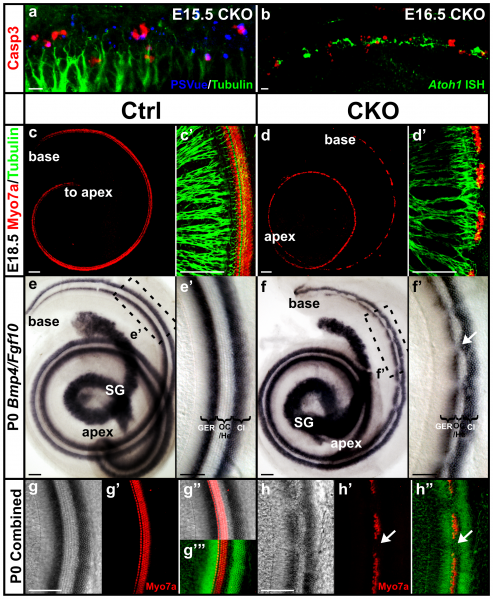File:Atoh1 hair cell loss.png

Original file (2,074 × 2,521 pixels, file size: 4.47 MB, MIME type: image/png)
Conditional deletion of Atoh1 results in death of organ of Corti cells and patchy Myo7a-positive presumptive hair cells which are innervated by many nerve fibers.
(a–b) Cell death assay using immunohistochemistry of activated Caspase 3 (red) and PSVue staining (blue) shows that many cells undergo cell death in E15.5 and E16.5 CKO ears. Whole mount cochlea is shown with the lateral wall to the top and the modiolus to the bottom. Dying cells are seen in the region equivalent to the organ of Corti based on their location in close proximity to the nerve fibers shown by Tubulin staining (green in a). When combined with Atoh1 in situ hybridization (false-colored in green in b), many Caspase 3-positive dying cells are found in between the Atoh1-expressing cells (b). (c–d’) Myo7a and Tubulin immunostaining shows presumptive hair cells and their innervation in E18.5 cochlea. In contrast to the stereotyped one row of inner and three rows of outer hair cells seen in control cochlea (c’), the Myo7a-positive hair cells are reduced to only one to two rows in the CKO cochlea (d’). They are continuous in the apex but become patchy in the base with gaps in between (d, d’). The remaining hair cells apparently attract most of the nerve fibers that innervate the mutant ear. (e–f’) Double in situ hybridization for Bmp4 and Fgf10 shows the boundaries of the organ of Corti. Bmp4 is expressed in Claudius cells lateral to the organ of Corti. Fgf10 is expressed in the greater epithelial ridge and defines the medial boundary. In the CKO cochlea, the two expression regions are in parallel in the apex (f) like the control (e). However, the Fgf10 expression is discontinuous at the base and the Bmp4 expression is expanded towards the gaps in the Fgf10 expression (f, f’). (g–h”) Immunostaining of Myo7a is combined with the Bmp4/Fgf10 double in situ hybridization (false-colored in green in g’” and h”) and shows that the Myo7a-positive hair cells are located between Bmp4 and Fgf10 expression regions. In the base of the CKO cochlea, the gaps between Myo7a-positive cells correlate with the area where Bmp4 expression is expanded towards GER (arrows in h’ and h”). Cl, Claudius cells; GER, greater epithelial ridge; He, Hensen’s cells; OC, organ of Corti; SG, spiral ganglion. Bar indicates 10 µm in a, b and 100 µm in c–h”.
Reference: <pubmed>22279587</pubmed>
Copyright: © 2012 Pan et al. This is an open-access article distributed under the terms of the Creative Commons Attribution License, which permits unrestricted use, distribution, and reproduction in any medium, provided the original author and source are credited.
- Note - This image was originally uploaded as part of an undergraduate science student project and may contain inaccuracies in either description or acknowledgements. Students have been advised in writing concerning the reuse of content and may accidentally have misunderstood the original terms of use. If image reuse on this non-commercial educational site infringes your existing copyright, please contact the site editor for immediate removal.
File history
Click on a date/time to view the file as it appeared at that time.
| Date/Time | Thumbnail | Dimensions | User | Comment | |
|---|---|---|---|---|---|
| current | 16:53, 29 September 2012 |  | 2,074 × 2,521 (4.47 MB) | Z3333865 (talk | contribs) | '''Conditional deletion of Atoh1 results in death of organ of Corti cells and patchy Myo7a-positive presumptive hair cells which are innervated by many nerve fibers.''' (a–b) Cell death assay using immunohistochemistry of activated Caspase 3 (red) and |
You cannot overwrite this file.
File usage
The following 2 pages use this file: